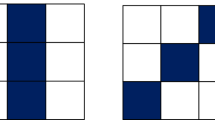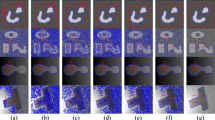Abstract
In this paper, we introduce multi-symplectic Lagrangian variational integrators for solving Chan-Vese active contour models in image segmentation. Energy functionals are discretized firstly, and numerical schemes are derived from discrete Euler-Lagrange equations based on discrete variational principle. Lagrangian variational integrators preserve native differential structure-multi-symplecticity, that makes the numerical methods have a satisfied behavior. Experiments are performed on the benchmark images from literature. We further evaluated the methods in a segmentation database containing 1023 images. It shows that the proposed numerical schemes attain relatively faster convergence rates and better segmentation accuracy. Comparisons with the standard explicit Euler method of the original Chan-Vese model and other fast numerical optimization methods show that the proposed methods have better stability, higher accuracy, and are more robust when dealing with a large number of pictures. This study provides an example for further research to improve the performance of other existing image segmentation methods based on active contour models.












Similar content being viewed by others
References
Adalsteinsson D, Sethian JA (1995) A fast level set method for propagating interfaces. J Contemp Math 118(2):269–277
Aubert G, Barlaud M, Faugeras O, Jehan-Besson S (2003) Image segmentation using active contours: Calculus of variations or shape gradients? SIAM J Appl Math 63(6):2128–2154
Badshah N, Chen K (2009) On two multigrid algorithms for modeling variational multiphase image segmentation. IEEE Trans Image Process 18(5):1097–1106
Bar L, Sapiro G (2009) Generalized newton-type methods for energy formulations in image processing. SIAM Journal on Imaging Sciences 2(2):508–531
Boukerroui D (2012) Efficient numerical schemes for gradient vector flow. Pattern Recogn 45(1):626–636
Bresson X, Esedoḡlu S, Vandergheynst P, Thiran J-P, Osher S (2007) Fast global minimization of the active contour/snake model. Journal of Mathematical Imaging and vision 28(2):151–167
Caselles V, Sapiro G, Kimmel R (1997) Geodesic active contours. Int J Comput Vis 22(1):61–79
Chan TF, Vese LA (2001) Active contours without edges. IEEE Trans Image Process 10(2):266–277
Chan TF, Esedoḡlu S, Nikolova M (2006) Algorithms for finding global minimizers of image segmentation and denoising models. SIAM J Appl Math 66 (5):1632–1648
Chartrand R, Staneva V (2008) A faster-converging algorithm for image segmentation with a modified chan-vese model. In: IPCV, pp 212–216
Csurka G, Perronnin F (2011) An efficient approach to semantic segmentation. Int J Comput Vis 95(2):198–212
Feddern C, Weickert J, Burgeth B (2003) Level-set methods for tensor-valued images. In: Proceedings of the 2nd IEEE Workshop on Geometric and Level Set Methods in Computer Vision, pp 65–72
Feng K, Qin M (2010) Multisymplectic and variational integrators. In: Symplectic Geometric Algorithms for Hamiltonian Systems. Springer, Berlin Heidelberg, pp 641–661
Focardi M, Mariano PM (2008) Convergence of asynchronous variational integrators in linear elastodynamics. Int J Numer Methods Eng 75:755–769
Focardi M, Mariano PM (2009) Discrete dynamics of complex bodies: variational integrators and convergence. Discrete and Continuous Dynamical Systems C B 11:109–130
Forsyth DA, Ponce J (2011) Computer vision: a modern approach. Prentice Hall, Upper Saddle River; London
Ge F, Wang S, Liu T (2007) New benchmark for image segmentation evaluation. J Electron Imaging 16(3):033011–033011-16
Kobayashi T, Otsu N (2012) Efficient similarity derived from kernel-based transition probability. In: Computer Vision–ECCV 2012. Springer, pp 371–385
Lankton S, Nain D, Yezzi A, Tannenbaum A (2007) Hybrid geodesic region-based curve evolutions for image segmentation. In: Medical Imaging, International Society for Optics and Photonics, pp 65104U–65104U
Lee S-M, Abbott AL, Clark NA, Araman PA (2005) Active contours on statistical manifolds and texture segmentation. In: IEEE International Conference on Image Processing, 2005. ICIP 2005, vol 3. IEEE, pp III–828
Li Z, Liu Z, Shi W A fast level set algorithm for building roof recognition from high spatial resolution panchromatic images
Marsden JE, Patrick GW, Shkoller S (1998) Multisymplectic geometry, variational integrators, and nonlinear pdes. Commun Math Phys 199(2):351–395
Mendi E, Milanova M (2009) Quasi-newton minimization for active contours with chan-vese model. In: IPCV, pp 575–578
Osher S, Sethian JA (1988) Fronts propagating with curvature-dependent speed: algorithms based on hamilton-jacobi formulations. J Comput Phys 79(1):12–49
Pan Y, Birdwell JD, Djouadi SM (2006) Efficient implementation of the chan-vese models without solving pdes. In: 2006 IEEE 8th Workshop on Multimedia Signal Processing. IEEE, pp 350–354
Pereyra M, Batatia H, McLaughlin S (2013) Exploiting information geometry to improve the convergence properties of variational active contours. IEEE Journal of Selected Topics in Signal Processing 7(4):700–707
Pi L, Shen C, Li F, Fan J (2007) A variational formulation for segmenting desired objects in color images. Image Vis Comput 25(9):1414–1421
Ren D, Zuo W, Zhao X, et al (2013) Fast gradient vector computation based on augmented Lagrangian method. Pattern Recogn Lett 34(1):219–225
Scheuermann B, Rosenhahn B (2009) Analysis of numerical methods for level set based image segmentation. In: Advances in Visual Computing. Springer, pp 196–207
Scheuermann B, Schlosser M, Rosenhahn B (2013) Efficient pixel-grouping based on dempsters theory of evidence for image segmentation. In: Computer Vision–ACCV 2012. Springer, pp 745–759
Shi Y, Karl WC (2005) A fast level set method without solving pdes. In: ICASSP (2), pp 97–100
Shi J, Malik J (2000) Normalized cuts and image segmentation. IEEE Transactions on Pattern analysis and machine intelligence 22(8):888–905
Sundaramoorthi G, Yezzi A, Mennucci AC (2007) Sobolev active contours. Int J Comput Vis 73(3):345–366
Sundaramoorthi G, Yezzi A, Mennucci AC, Sapiro G (2009) New possibilities with sobolev active contours. Int J Comput Vis 84(2):113–129
Sussman M, Fatemi E (1999) An efficient, interface-preserving level set redistancing algorithm and its application to interfacial incompressible fluid flow. SIAM J Sci Stat Comput 20(4):1165–1191
Vankerschaver J, Liao C, Leok M Generating functionals and lagrangian pdes, arXiv:1111.0280
Vese LA, Chan TF (2002) A multiphase level set framework for image segmentation using the mumford and shah model. Int J Confl Manag 50(3):271–293
Wang Z, Vemuri BC (2004) Tensor field segmentation using region based active contour model. In: Computer Vision-ECCV 2004. Springer, pp 304–315
Zhang L, Song H, Zhang K (2010) Active contours driven by local image fitting energy. Pattern recognition 43(4):1199–1206
Acknowledgements
The authors would like to thank all the reviewers for their constructive comments. This research was supported by National Natural Science Foundation of China(Grant No.61170121, No.11401259), Blue Project of Universities in Jiangsu Province Training Young Academic Leaders Object, Fundamental Research Funds for the Central Universities(JUSRR11407).
Author information
Authors and Affiliations
Corresponding author
Rights and permissions
About this article
Cite this article
Liang, J., Li, M. & Liao, C. Efficient numerical schemes for Chan-Vese active contour models in image segmentation. Multimed Tools Appl 77, 16661–16684 (2018). https://doi.org/10.1007/s11042-017-5232-6
Received:
Revised:
Accepted:
Published:
Issue Date:
DOI: https://doi.org/10.1007/s11042-017-5232-6




